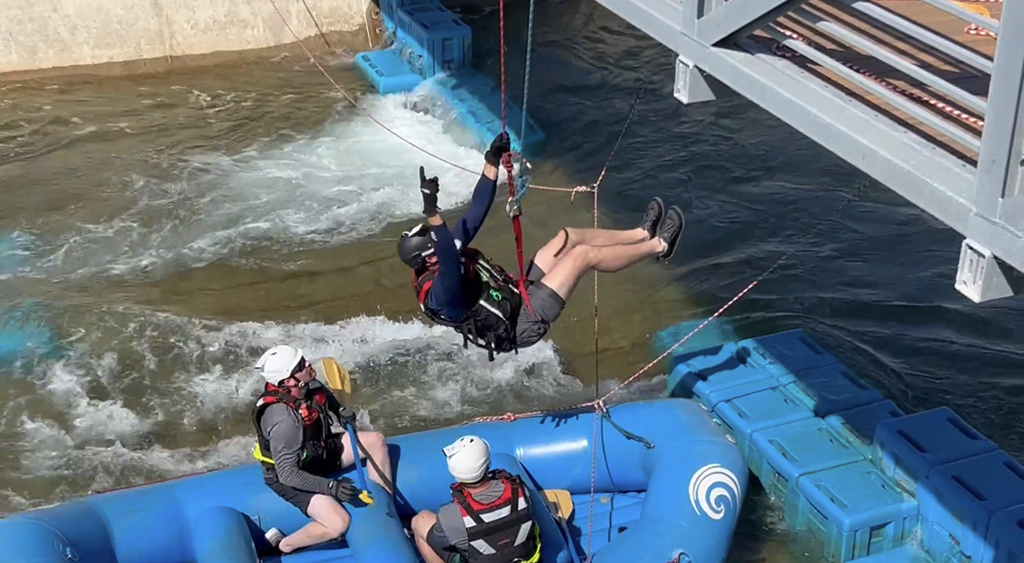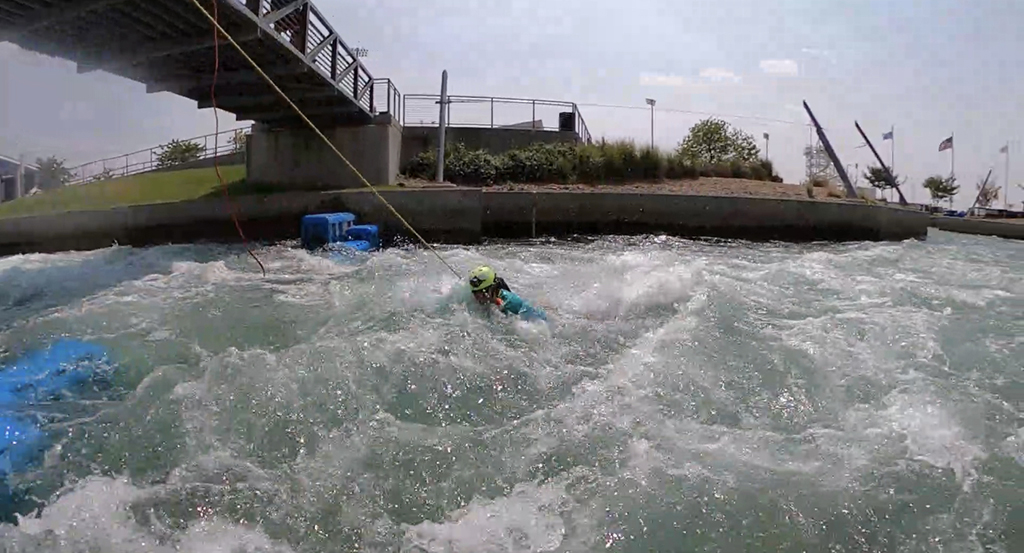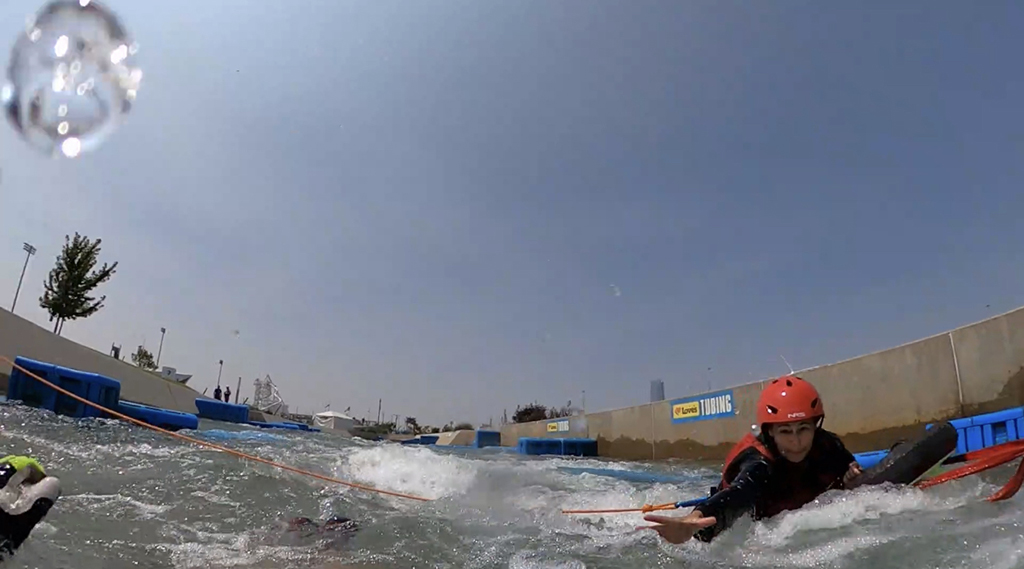LEADERSHIP and command presence are as vital to a water rescue outcome as the rescue selection, tactics, and execution. As rescuers, we talk about the importance of training the hands-on skills we need to ensure a safe and successful rescue. We focus our training on various skills and skill sets that we use during our rescues. However, during training we often overlook leadership skills at rescue scenes. These skills are as important as, if not more important than, the rescue itself (photo 1).
- The Dirty Dozen of Swiftwater Rescue
- Fundamentals of Open Water Rescue
- SWIFTWATER: Key to Command and Control at Water Rescues
They include the following:
- Scene size-up.
- Allocation of resources.
- Command and control.
- Safety.
- Command presence.
As in any emergency response, the most critical evaluation is the ABCs:
- Airway.
- Breathing.
- Circulation.
The same is true in water rescue incidents. The difference, however, is in what those ABCs stand for:
- Assessment.
- Backup and boundaries.
- Command and control.
Is Leadership Inherent or Learned?
We often perceive leadership as an inherent skill. In fact, many people think of it as something that cannot be developed and does not require training. This is incorrect on every level.

1. Water rescue incidents require a strong command presence with knowledgeable guidance and direction. (Photos by author.)

2. Ground ladder skills in water rescue may help rescuers and victims avoid entering the water.
Let’s backpedal a bit. Yes, some people have innate leadership qualities. But, as with any skill, you can also develop and improve your leadership skills through training and appreciating its importance at rescue scenes. And when it comes to water rescue, we often focus on the rescue itself and overlook the importance of command and leadership at these scenes.
Understanding the role of the incident commander (IC) at a water rescue is as basic as understanding the ABCs of leadership at water rescues. Here’s a closeup look at those ABCs.
Assessment of the Scene
Every water rescue scene comes with its own challenges. Even if your team has made multiple rescues at a particular site, each incident is unique. On arrival at the incident, the IC must assess several factors and process and account for each one prior to making rescue-selection decisions.
Victim Assessment
One of the first command assessments is victim based. Questions you need to consider, as the rescuer, include the following:
- Is there a viable victim?
- Is the victim alive or deceased?
- How many victims are there?
- Can we see the victim?
- Do we have access to the victim?
- With multiple victims, how do we prioritize which victim to rescue first?
Victim analysis is critical when you’re deciding whether the situation warrants a rescue. A confirmed deceased victim immediately eliminates a high-risk rescue selection. The number of victims determines the potential need for additional assets within your own agency or through mutual-aid departments. If you can see the victim, you can evaluate whether you need to make an immediate rescue or if there is time to develop a methodical rescue plan (photo 2).
If the victim is hanging from a tree branch and about to lose his grip, the risk level and necessary speed to act increase. If the victim is safe in a tree out of the water with a sure grip, then time is on your side. And under these circumstances, you also have a reduced risk level for rescue selection.
Here are a few additional questions to consider:
- Is access to the victim easy or is additional equipment and personnel required?
- Does the rescue team need to use rope rescue for access (photo 3)?
- Can the rescue team use an aerial device to assist with victim access?
- Is a boat or raft necessary for you to gain access?

3. Water rescues involve more than just water skills. Water rescue professionals must be proficient in rope rescue operations as well.
Prioritization of victims is part of the IC’s assessment. Victim priority is based on many factors. If an incident includes several victims, each of whom can be easily accessed and require little technical expertise, those victims may becomepriority rescues over one victim who is going to be very time consuming and requires strong technical rescue skills.
However, the single, more time-consuming victim may be a priority based on the lack of danger facing the group of victims in comparison to the immediate risk of danger to the single victim. Whatever decision is made in prioritizing victims, this will dictate rescue, personnel, and equipment needs. As the rescuer, when you answer these questions and analyze the data, you’ll make better decisions.
Water Assessment
The next assessment involves the water. You’ll need to consider the following factors:
- Water speed.
- Water depth.
- Water temperature.
Immediately on arrival, assess the water conditions. The speed of the water can help determine where a victim would be if one fell in the water. If the water speed is estimated to be at six miles per hour and the victim is reported to have fallen in the water 20 minutes ago, the victim can be estimated to be two miles downstream. This information can help determine the search area for the victims.
You’ll also need to note the water’s depth. Throughout the incident, consistently evaluate the depth. This will help you assess whether conditions are getting better, getting worse, or staying the same. Having the water depth will also help you with decision making on rescue selection. You’ll be considering the following questions:
- Does the depth allow wade rescues?
- Are boats necessary to gain access to the victim?
- Are other access tactics necessary, such as aerials?
Another key component of your initial assessment is water temperature. The temperature’s effect on the victim—on both mental and physical capabilities—is something we often overlook. Hypothermia can affect the victim’s decision-making process. It can make a victim’s decisions very unpredictable, as it greatly impairs cognitive skills.
Expect any victim’s strength and physical abilities to be limited due to hypothermic symptoms. Hydrology is important for you to assess during rescues, and this needs to happen during the size-up. A proper hydrology evaluation can identify water hazards. It can also assist with identifying water depths.
Use devices to get an aerial view to assess the entire area that may affect the rescue and rescue selection. Here are a few examples of devices you can use for this:
- Mobile data computer.
- Tablet, such as an iPad.
- Phone.
- Drones.
Drones provide real-time aerial pictures of the incident area. They supplement information from mobile data computers, tablets, and phones. Drones supply information in real time and these other devices do not. However, they do offer a view ofthe area prior to flooding. They can help identify hazards that may be covered up by flowing water. Search crews may also put aerial footage to use to assess the presence of hazards downstream. These hazards can include hydraulics, strainers, low head dams, and obstructions.
Backups and Boundaries
Backups and boundaries are essential elements when you’re establishing incident command at water rescue incidents (photos 4 & 5). Backups refer to downstream safety and upstream spotters. Without a strong command presence, the operation will focus fully on the rescue. You’ll need to place crews downstream and upstream. Not doing so will compromise spotters’ safety. This misstep can lead to disaster for the victim and rescuers.

4. Teamwork and coordination are important to successful operations.

5. Rescuer positioning is important to facilitate a safe and successful rescue.
Upstream spotters allow the rescue team to learn about any hazards that may be approaching the rescue area and allow them time to adjust their positioning or modify their rescue safely. Downstream safety is there in case a rescue is not effective and the victim washes downstream. This is an important aspect of any rescue.
However, what makes the downstream safety position the most critical position is the fact that it is designed to rescue our own in the case of a failed rescue as well. Downstream safety is the rapid intervention team of water rescue. Downstream safety is a rescue team in place to rescue personnel and victims and prevent them from reaching danger areas that they may not see or be able to avoid without assistance.
Boundaries designate the area of rescue. Establishing boundaries uses the information gathered to brief crews on the area. Hasty search teams can be placed in various areas to cover the largest area in the shortest amount of time while maintaining efficiency and effectiveness.
When you define boundaries, you’ll bracket the area from a starting point. You’ll include the point where the victim entered the water and take the boundary past a point that the victim could not have passed, based on your water speed analysis during the assessment.
When you allocate resources, place crews at the bottommost point. Work upstream to locate the victim. At the same time, you should have additional hasty search teams start at the top. They’ll work downstream.
Search crews should receive victim in- formation that covers the following details:
- Number of victims.
- Gender of each victim.
- Ages.
- Physical limitations.
- Mental limitations.
- Clothing descriptions.
- Any other pertinent information.
While they search for the victim, instruct hasty search teams to identify possible points of detection that may require further searching later and identify hazards that may affect rescuers if they enter the water (photo 6). They can mark these points with GPS waypoints, glow sticks, or other marking devices. ICs must ensure all rescuers in the rescue area are properly trained and in proper personal protective equipment (photo 7). You’ll also need boundaries for nonwater rescue personnel, bystanders, and media. Work with law enforcement to manage the rescue area. Keep the media and bystanders in a safe area that does not disrupt your department’s work.

6. Water rescues may involve multiple rescue techniques to include rope ops, raft ops, and paddling in addition to basic water rescue skills.

7. Strong swimming skills are necessary for any water rescue professional.
Command and Control
Command and control are imperative components of all rescue operations. Firefighters are consistent and diligent in establishing command on fire incidents and using the incident management system. In water rescue incidents, the command portion is not emphasized because rescue teams focus strictly on the victim and the rescue selection. We also see diminished incident command at water rescue incidents due to lack of on-scene staffing and personnel.
Regardless of an organization’s size, everyone seems to be short on personnel. However, this is no excuse for lack of command and control at water rescue scenes. Mutual-aid companies can assist in adding more on-scene personnel and equipment to allow for a standalone IC at water rescue incidents.
Leaders within your organization should get training that offers them an understanding of the needs, hazards, and assessment of water rescue scenes.
Water rescue professionals are great at organizing training scenarios to improve their response capabilities but that often do not emphasize the command needs. Training focuses on the rescue itself. When water rescue teams train, it would make a big difference if they included officers and chiefs as part of the training. This would allow officers and chiefs to develop an understanding of water rescue incidents and rescue needs. They could use the incident command skills they honed throughout their years of training and scene management and apply it to water rescue incidents. Commanding an incident with zero knowledge and understanding of the discipline you’re commanding is difficult. And it could be an effort in futility.
Command presence is vital to command and control of a water rescue incident. It includes the following:
- Establishing a proper incident management system.
- Assessing the scene.
- Allocating resources.
- Identifying the incident area and the hazards within.
When the IC portrays confidence in decision making, his role as the leader of the incident provides trust and faith in his decisions and in the tactics and techniques during the rescue. Of course, training rescue crews is essential to safe and successful water rescues. And a strong command presence is critical to allowing the IC to stay focused on his assigned task. When the IC conveys doubt in his decisions or loses his cool during the incident, personnel on scene follow that lead.
This type of “mob mentality” can be seen on a rescue scene that lacks command presence. When the IC is uptight, slow to make decisions, unconfident, and apprehensive, then the most well-trained crews will allow doubts to creep into their mindset. Once crews lose faith in command and doubts come into play, we start to see freelancing. And once crews doubt leadership and start to do their own thing, the IC will lose all scene control and crew focus. At this point, you may start to see mistakes that lead to accidents and injuries. Lack of command and control can lead to loss of accountability. And that can lead to possible disaster for the victim and for the rescue teams.

8. Water rescue technicians must be prepared for in-water and shore-based rescues.
Command and control at water rescue incidents are as important as the rescue itself. They ensure a safe and successful outcome. ICs must assess the scene and identify hazards and safe zones. This includes water conditions and allocation of resources. ICs must establish boundaries so rescue teams can identify the rescue area and ensure the safety of nonrescue first responders, bystanders, and the media.
It’s possible to get the right kind of experience in commanding water rescue incidents through training with rescue teams (photo 8). This training gives teams the tools they need to understand capabilities, needs, and limitations.
The Big Picture
Successful rescues depend on effective and safe execution of the rescue, led by strong incident command with all the following pieces falling into place:
- Proper decision making.
- Risk-benefit analysis.
- Size-up.
- Allocation of resources.
- Command presence.
When you maintain the ABCs (assessment, backups and boundaries, and command and control), you’re making effective and successful incident command possible for your department.
GREG MERRELL is a battalion chief with the Oklahoma City (OK) Fire Department. He is a task force leader for OK-TF 1 US&R Team, leading multiple national and statewide deployments. Merrell instructs first responders and military personnel across the United States and Australia in water rescue, boat operations, and disaster response.


